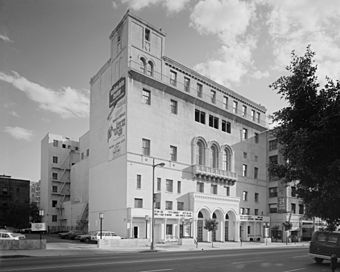Friday Morning Club facts for kids
Quick facts for kids |
|
|
Friday Morning Club
|
|

Friday Morning Club, in 1980.
|
|
| Location | 940 South Figueroa Street Los Angeles, California |
|---|---|
| Built | 1923 |
| Architect | Allison & Allison |
| Architectural style | Italian Renaissance Revival |
| NRHP reference No. | 84000865 |
| Added to NRHP | May 17, 1984 |
The Friday Morning Club building is in Downtown Los Angeles, California. It was the second home for a special women's club, also called the Friday Morning Club (FMC). This building was their meeting place for 61 years.
The club's large, six-story building was designed by architects Allison & Allison. It was built in 1923. The style is called Italian Renaissance Revival, which means it looks like old Italian buildings.
Contents
Club History
The Friday Morning Club was started in 1891 by Caroline Severance. She was an amazing woman who wanted to end slavery (an abolitionist). She also fought for women's right to vote (a suffragist). Caroline and 87 other women began the club in a hotel reading room.
The Friday Morning Club grew to be the biggest women's club in California. By the 1920s, it had over 1,800 members!
Women's clubs were very important for middle-class women in America. They offered a place for women to learn and socialize. This was especially true from the end of the Civil War until the mid-1900s. As women gained more opportunities in business and education, the need for these clubs changed.
Caroline Severance had already started one of the first women's clubs in the country. It was the New England Women's Club in Boston, founded in 1868. The Friday Morning Club became known for being very active in politics. They worked hard to improve the community in Los Angeles.
The club members wanted to learn new things and study art, literature, and culture. They also worked to help women get ahead in society and politics. To do this, many women's clubs built their own clubhouses. To protect their money, clubs often formed a special company. This helped them raise funds for their clubhouse.
Clubhouse History
The Friday Morning Club's first clubhouse was in the same spot. It was a two-story building built in 1900. It cost $25,000 and was in the Mission Revival style.
During World War I, the club got many more members. Their first building became too small. So, the Friday Morning Club took it apart and sold it. They then built the current six-story building in 1923.
This new building had two auditoriums and could seat almost 2,000 people. This was perfect for the club's popular art and theater shows in the 1920s and 1930s.
The Figueroa Hotel was built right across the street in 1925. It was also funded and run by women. It helped businesswomen and women traveling in Los Angeles. Both buildings show how important women were becoming in American society in the 1920s.
New Owners and Uses
In 1977, the club sold the building to the Society for the Preservation of Variety Arts. This group used the main auditorium for live plays, music shows, and old radio dramas. They also rented it out for filming and special events. The Society also showed off many theater art collections in the building. Their library is open for students who want to research theater.
The Friday Morning Club members kept meeting and helping the community. They leased the 5th floor of the building for a while. Later, they rented space on Wilshire Boulevard until the 1990s. Today, the Ebell of Los Angeles is the largest women's club in the city. It has about 400 members and a big clubhouse built in 1927.
The building was sold to AEG in 2004. Then, a developer named David Houk bought it in 2007. In 2015, Hillsong Church Los Angeles announced they would lease the building for 15 years. They planned to use it for church services and offices. After many updates, Hillsong LA moved into the building in early 2017.
Landmark Status
The Friday Morning Club building is a Los Angeles Historic-Cultural Monument. This means it's a very important historical site in Los Angeles. It was also added to the National Register of Historic Places in 1984. This shows its importance for both social history and its beautiful architecture.
Notable Members
- Lillie Stella Acer Ballagh
- Mabel B. Dunn
- Nannie C. Dunsmoor
- Oda Faulconer
- Georgia Thatcher Kemp
- Sarah Bixby Smith (who was also a president of the club)
See also


